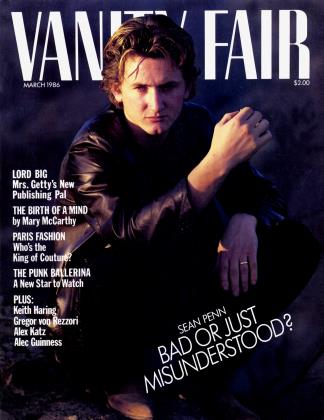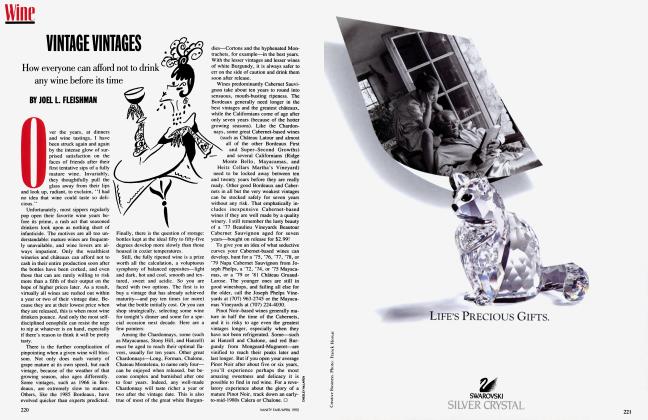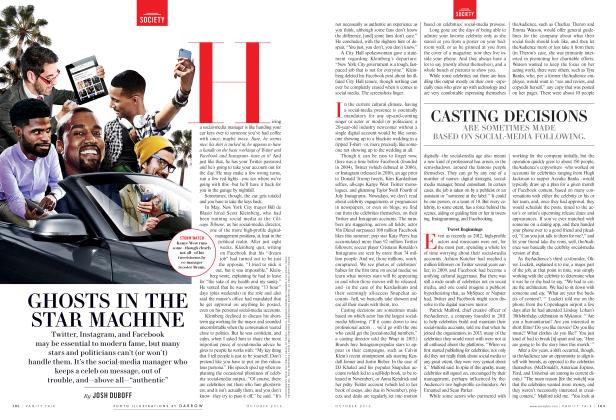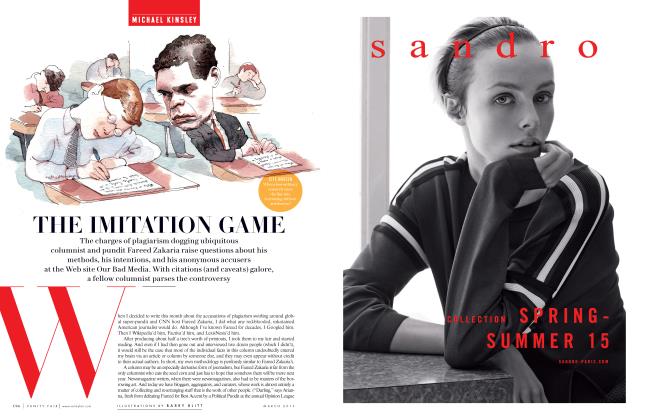Sign In to Your Account
Subscribers have complete access to the archive.
Sign In Not a Subscriber?Join NowVintage Point
JOEL L. FLEISHMAN
The Subtlest Grape
In contrast to reds, most white wines are ethereal, shy, and retiring; it is necessary to dig deep to discern their specific flavors. Indeed, some are so delicate that one perceives only the perfume of green apples and lemon. Chardonnays, however, lend themselves to a very broad and variable range of taste sensations. In some the tartness of citrus predominates, while in others one can savor combinations of honey, melon, and vanilla.
In few other wines do the taste preferences one brings to the table make so great a difference in determining likes and dislikes. Aesthetes whose delicate sensibilities are offended by the presence of any fruitiness, perish the thought, will be distressed by the very same Chardonnay which pleases the thirst for intense, rich flavors. Those who prefer chewy wines—wines with complex textures and conflicting flavors that are lipsmacking good—will find simple, subtly perfumed Chardonnays so unsatisfying as to be not worth the calories they contain. Those who revel in rich, forward flavors will find oakiness, which comes from barrel aging or barrel fermenting, an unjust imprisonment of the glories of the grape. Fortunately, however, there are Chardonnays for every taste, and if one is anything less than a zealot, it is possible to take pleasure even from that which is not one's true love.
I prefer a Chardonnay that starts with a leading edge of fruit flavors so intense that one has the sensation of sweetness, challenged quickly by the pungency of tobacco, the freshness of apples, and the tartness of lemon—all combined within a narrow frame of oak. And I am surprised by how often I am satisfied by this subtlest of grapes.
In a recent blind tasting, for instance— despite the wide range of personal preferences present, the broad price range of Chardonnays included, and the varying experience of the participants—the degree to which all of the tasters expressed satisfaction was astonishing to me. Following are the twenty Chardonnays which were included, arranged by flight and by their place in the tasting.
Flight one: 1983 Raymond Napa Valley ($11.99); 1983 Sonoma-Cutrer Russian River Ranches ($11.49); 1983 Edna Valley Vineyard ($13); 1983 Robert Mondavi Winery ($13.80); 1984 Glen Ellen Proprietor's Reserve ($5.89); 1983 Dolan Vineyards Mendocino County ($14); 1983 Pouilly-Fuisse Domaine Manciat-Poncet ($14.29); 1983 Beringer Napa Valley ($9.69); 1983 Veeder Ridge ($9.99); 1982 Rutherford Hill Jaeger Vineyards ($11.65).
Right two: 1982 Trefethen Vineyards Napa Valley ($15.45); 1983 Vichon ($15.55); 1983 Chateau St. Jean Robert Young Vineyards ($24.99); 1983 'Chateau Bouchaine Los Cameras ($15.19); 1983 Chalone Vineyard ($18.99); 1983 Meursault Louis Latour ($18.65); 1983 Chalone Vineyard ($18.69); 1984 Chalone Vineyard ($20.35); 1982 SonomaCutrer Cutrer Vineyard ($13.79); 1983 Corton-Charlemagne Domaine Michel Voarick ($29.95).
It is rare in a tasting of twenty wines that all of them will give pleasure, but such was the case. Not one was without some appeal. Nor was there any direct correspondence between price and quality. We were all struck, too, by the easy victory of California wine over some powerful competition from France.
In flight one, the Raymond—note that it is the "Napa Valley'' and not the "California," which is less expensive—captured the group crown, as well as my own personal first-place rating. It is a classically balanced, rich, complex apple/tobacco wine with a chewy finish. Second place went to the Sonoma-Cutrer Russian River Ranches, with its assertive lemon flavor and a touch of tobacco; the Edna Valley, from California, placed third, with a gorgeous fruit-and-tobacco bouquet and an intensity that some of us were certain must have been French in origin.
Flight two contained some of the biggest guns in the world of Chardonnay, both domestic and imported. None of us would have predicted that one of the less expensive wines, the Trefethen, would easily best some of those with giant reputations, yet it did, for the group and in my own ranking. Its powerful bouquet of apple and tobacco married beautifully with rich, forward, characteristic Chardonnay fruit. In second place was the Vichon, with an outgoing bouquet of apple, and rich flavors of apple and lemon in the mouth. The Chateau St. Jean ranked third, with an elusive bouquet but forward, simple, silky fruit flavors surrounded by oak.
One oddity is worth noting. I had intended to include a 1982 Chalone, but by accident two 1983s—one purchased locally and one in Chicago—were put in the brown paper bags used for the tasting. They ranked differently, although not widely apart, and we were all surprised that they proved to be one and the same. The better of the two came from a shop that has only incandescent light, and the bottle was stored in deep shelves where only the top bottles get light. The lesser wine came from a shop which is brightly lit with fluorescent bulbs, and where the bottles were lying in open cases. That underscores the caveat that wines are only as good as their provenance.
The best value in the tasting was the 1984 Glen Ellen Proprietor's Reserve, at $5.89, which the group ranked fifth in flight one, and I ranked third.
 View Full Issue
View Full Issue


















Subscribers have complete access to the archive.
Sign In Not a Subscriber?Join Now